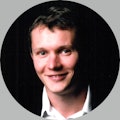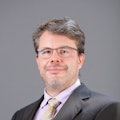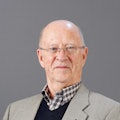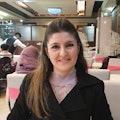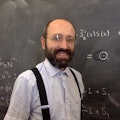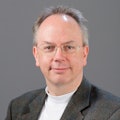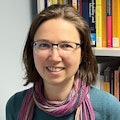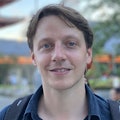Mathematical Analysis Research Group
Mae Dadansoddi Caerdydd yn cwmpasu ystod gyffrous o bynciau gan gynnwys theori sbectrol a geometreg sbectrol, meysydd cysylltiedig fel theori rhif dadansoddol a dadansoddi microleol, hyd at broblemau gwrthdro, delweddu, PDEs aflinol, homogeneiddio penderfyniadol a stocastig.
Ni yw un o grwpiau dadansoddi blaenllaw'r DU. O'r 1960au hyd at y 1990au, ein prif feysydd arbenigedd oedd theori sbectrol, theori gweithredwr, gofodau ffwythiant a hafaliadau gwahaniaethol rhannol llinellol, ynghyd â chymwysiadau'r holl syniadau hyn mewn ffiseg fathemategol.
O 2007 ymlaen rydym ni wedi ehangu ein diddordebau i gwmpasu meysydd newydd gan gynnwys:
- dadansoddi amgrwm
- dadansoddi mewn maniffoldau is-Riemannaidd
- problemau gwrthdro a delweddu
- hafaliadau gwahaniaethol rhannol aflinol
- homogeneiddio penderfyniadol a stocastig.
Mae ein gwaith yn cynnwys arbenigedd traddodiadol Prifysgol Caerdydd mewn theori rhif dadansoddol a phynciau yn y rhyngwyneb rhwng dadansoddi a theori rhif, fel geometreg sbectrol.
Rydym ni'n grŵp rhyngwladol gydag ymchwilwyr ac academyddion o'r Almaen, Israel, yr Eidal, Rwsia ac UDA, yn ogystal â'r Deyrnas Unedig. Mae ein cydweithrediadau rhyngwladol yn adlewyrchu hyn gyda phrosiectau ar waith gyda Bern, Birmingham (Alabama), Colorado School of Mines, Florence, Karlsruhe, Montréal, McGill, Padova, Pisa, Santiago, St Petersburg a Sefydliad Weizmann, yn ogystal â phrifysgolion yn y DU, yn enwedig ein cydweithwyr yn WIMCS a grŵp GW4.
Ymhlith aelodau diweddar o'r grŵp mae Michael Levitin, Igor Wigman a Kirill Cherednichenko.
Ymchwil
Mae ein prif gyfeiriadau ymchwil yn cynnwys:
- theori sbectrol, cymwysiadau a dulliau rhifiadol
- mecaneg cwantwm, problemau gwrthdro
- dulliau asymptotig ac amrywiadol ar gyfer hafaliadau gwahaniaethol rhannol aflinol, yn enwedig homogeneiddio (stocastig);
- hafaliadau differol rhannol geometrig a stocastig
- theori rhif cyfansoddiadol a dadansoddol, ffwythiannau arbennig
- cymhwyso dulliau dadansoddol (e.e. prosesu delweddau, geneteg feddygol, terfynau graddio ar gyfer systemau gronynnau rhyngweithiol).
Ffocws
Theori sbectrol
Yn 1966 gofynnodd Mark Kac y cwestiwn rhaglennol "A yw'n bosibl i rywun glywed siâp drwm?" h.y. a yw parth planar yn cael ei bennu'n unigryw (hyd at gyfathiant) gan sbectrwm ei Dirichlet Laplacian?
Ers hynny mae'r cwestiwn hwn wedi cael ei ateb yn negyddol, ond mae geometrig sbectrol - astudio sut mae nodweddion geometrig a thopolegol parthau a maniffoldau'n cael eu hadlewyrchu yn y sbectra o weithredwyr gwahaniaethol cysylltiedig - yn faes mathemategol llewyrchus gyda goblygiadau i theori rhif a ffiseg.
Mae ein diddordebau eraill mewn theori sbectrol yn cynnwys:
- gweithredwyr ffiseg fathemategol, er enghraifft cwestiynau sefydlogrwydd yn cynnwys amcangyfrifon ansoddol a meintiol ac asymptotigau lled-glasurol ar gyfer gweithredwyr yn deillio o'r gweithredwr mecaneg cwantwm berthnaseddol Dirac, megis gweithredwr Brown-Ravenhall, ac estyniadau i leoliad damcaniaethol maes cwantwm
- problemau nad ydynt yn hunan-atgydio, gan gynnwys brasamcanu sbectrol, llygredd a gweithredwr sbectrol gyda strwythur bloc arbennig
- problemau sbectrol gwrthdro, gan gynnwys problemau delweddu a systemau Maxwell
- triphlygion ffin a'u cymwysiadau i theori sbectrol (systemau) PDEs.
PDEs geometrig a stocastig
Mae llawer o broblemau ffisegol, yn arbennig y rheini sy'n ymwneud â thrawsnewid gwedd, niwcleiddio a hafaliadau esblygiad ar gyfer ffiniau a rhyngwynebau rhydd, yn cynnwys modelau mathemategol lle ceir digon o anhrefn ar raddfa hyd ddigon bach fel bod y dadansoddiad mwyaf effeithiol o'u datrysiadau macrosgobig yn golygu dadansoddi hafaliadau gwahaniaethol rhannol gyda chyfernodau stocastig a therfynau graddio. Rydym yn gweithio ar sawl pwnc yn y meysydd hyn, gan gynnwys:
- rhyngwynebau mewn cyfryngau heterogenaidd ac ar hap a PDEs aflinol cysylltiedig
- Prosesau Stocastig rhyngweithiol a'u terfynau graddio; PDEs aflinol stocastig
- PDEs aflinol a Phrosesau Stocastig
- homogeneiddio a chydgyfeiriant-Gamma
- terfynau graddio hafaliadau gwahaniaethol a aflonyddir yn unigol
Dull modern iawn arall o ymdrin â rhai dosbarthiadau o hafaliadau gwahaniaethol rhannol aflinol yw drwy syniadau a ddaw o geometreg. Mae gennym ddiddordebau penodol mewn problemau'n ymwneud â maniffoldau is-Riemanaidd, nad ydynt yn isomorffig i ofod Ewclidaidd ar unrhyw raddfa hyd. Yn y cyd-destunau hyn rydym ni wedi gallu addasu technegau o galcwlws o amrywiadau, a chyffredinoli syniadau o amgrymedd, sy’n gadael i ni drin PDEs is-eliptig ac uwch-barabolig. Mae'r hafaliadau hyn yn digwydd mewn llawer o gymwysiadau annisgwyl a newydd, gan gynnwys modelu'r haen gyntaf o'r cortecs gweledol a phroblemau mewn cyllid yn gysylltiedig â phrisio opsiynau Asiaidd.
Theori rhif dadansoddol
Sefydlwyd Theori Rhif Caerdydd gan yr Athro Christopher Hooley FRS ac mae'n dal i fod yn un o'n meysydd mwyaf poblogaidd ar gyfer astudiaethau doethurol.
Rydym ni'n weithredol mewn ymchwil ar nifer o bynciau clasurol:
- rhifau cysefin
- ffwythiant zeta Riemann
- polynomialau Dirichlet
- symiau esbonyddol
- symiau Dedekind
- symiau Kloosterman
- y grŵp modiwlaidd
- ffurfiau tonnau Maass
- fformiwlâu olrhain Selberg a Kuznetsov
- pwyntiau dellt yn y plân a phroblem cylch Gauss
- gwahanol gyfluniadau o bwyntiau dellt mewn siâp sy'n symud, yn ogystal â phwyntiau cyfanrif yn agos at hyperarwynebau a pholytopau.
Mae gennym ddiddordeb hefyd mewn problemau yn y rhyngwyneb rhwng theori rhif a theori sbectrol, fel arfer yn codi o geometreg sbectrol.
Prosiectau
Rydym ni'n ddiolchgar i'n noddwyr ymchwil am y llif cyson o gyllid maen nhw wedi parhau i'w ddarparu dros flynyddoedd lawer. Yn y gorffennol mae ein noddwyr wedi cynnwys Ymddiriedolaeth Leverhulme, rhaglen Marie Curie yr Undeb Ewropeaidd a'r Gymdeithas Frenhinol yn ogystal â'r EPSRC. Mae ein noddwyr presennol yn cynnwys Cymdeithas Fathemategol Llundain a'r EPSRC sy'n cyllido'r prosiectau canlynol:
Cwrdd â'r tîm
Digwyddiadau
Seminarau
Ewch i'n calendr digwyddiadau i weld pa gyflwyniadau ar-lein sydd ar y gweill gennym
Digwyddiadau blaenorol
- Seminarau Dadansoddi Mathemategol 2019-20
- Seminarau Dadansoddi Mathemategol 2017-18
- Seminarau Dadansoddi Mathemategol 2015-16
Caerfaddon - Cyfarfodydd dadansoddi WIMCS
25/09/2015
Noddir y cyfarfodydd hyn gan LMS Scheme Three Grant.
Caerfaddon - cyfarfod WIMCS Caerdydd
Rhwydwaith y De-orllewin mewn Atebion Cyffredinol ar gyfer cyfarfodydd PDEs Aflinol
12/02/2016
Trefnir y cyfarfodydd hyn gan Brifysgol Caerdydd, Prifysgol Reading a Phrifysgol Caerfaddon.
Tueddiadau newydd mewn PDEs aflinol
20/06/2016 - 25/06/2016
Nod y gweithdy hwn yw dod ag ymchwilwyr at ei gilydd o fewn meysydd ymchwil gweithgar iawn yn ddiweddar sy'n gysylltiedig â hafaliadau gwahaniaethol rhannol aflinol (PDEs), yn enwedig lle mae'r rhain yn croesi ffiniau disgyblaethau mathemategol.
Camau nesaf
Ymchwil sy’n gwneud gwahaniaeth
Mae ein hymchwil yn gwneud gwahaniaeth i fywydau pobl wrth i ni gweithio ar draws disgyblaethau er mwyn ymgodymu â phrif heriau sy’n wynebu’r gymdeithas, yr economi ac ein hamgylchedd.
Ymchwil ôl-raddedig
Mae ein graddau ymchwil yn rhoi'r rhyddid i chi i archwilio pwnc arbennig mewn dyfnder ymhlith ymchwilwyr blaenllaw.
Ein heffaith ymchwil
Mae'r astudiaethau achos hyn yn rhoi sylw i rai o'r meysydd lle rydym yn cael effaith ymchwil gadarnhaol.



